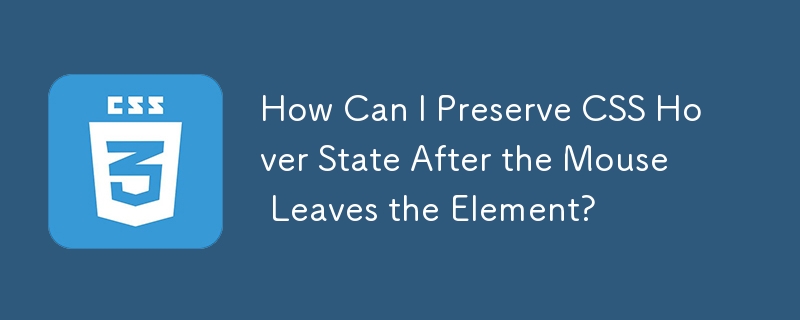 Web Front-end
Web Front-end
 CSS Tutorial
CSS Tutorial
 How Can I Preserve CSS Hover State After the Mouse Leaves the Element?
How Can I Preserve CSS Hover State After the Mouse Leaves the Element?
How Can I Preserve CSS Hover State After the Mouse Leaves the Element?

Preserve CSS Hover State After "Unhovering"
In web design, the hover state is commonly used to display additional content on mouse hover. However, by default, this content disappears when the mouse cursor leaves the specified area. This article presents a CSS solution to keep the hover state visible after "unhovering" the cursor.
The provided example utilizes the ':hover' pseudo-class to reveal an image when hovering over a div. However, the image disappears when the hover event ends. To address this, the following CSS technique can be employed:
div img {
position: absolute;
opacity: 0;
transition: 0s 180s;
}
div:hover img {
opacity: 1;
transition: 0s;
}
div {
line-height: 1.2em;
font-size: 1em;
color: black;
transition: 0s 180s;
}
div:hover {
line-height: 0;
font-size: 0;
color: transparent;
transition: 0;
}This code uses a combination of absolute positioning, opacity, and transitions to achieve the desired effect. The opacity is initially set to 0, making the image invisible. On hover, the opacity is set to 1, revealing the image. To prevent the content from disappearing on "unhover," the transition property is used with a delay of 180 seconds (3 minutes). This delay effectively inhibits the opacity transition, keeping the image visible indefinitely.
Alternatively, it is also possible to use focus events to ensure that the image remains visible when clicked:
div:hover img:focus {
opacity: 0;
transition: 3s;
-webkit-transform: rotate(-360deg) scale(0.23);
-webkit-transform: rotate(-360deg) scale(0.23);
-moz-transform: rotate(-360deg) scale(0.23);
-o-transform: rotate(-360deg) scale(0.23);
-ms-transform: rotate(-360deg) scale(0.23);
transform: rotate(-360deg) scale(0.23);
}This variant uses focus events and transitions to fade out and rotate the image after it is clicked, keeping it visible during the transition.
By implementing these CSS techniques, you can modify the hover state behavior to maintain the visibility of desired content even after the mouse cursor leaves the specified area.
The above is the detailed content of How Can I Preserve CSS Hover State After the Mouse Leaves the Element?. For more information, please follow other related articles on the PHP Chinese website!

Hot AI Tools

Undresser.AI Undress
AI-powered app for creating realistic nude photos

AI Clothes Remover
Online AI tool for removing clothes from photos.

Undress AI Tool
Undress images for free

Clothoff.io
AI clothes remover

Video Face Swap
Swap faces in any video effortlessly with our completely free AI face swap tool!

Hot Article

Hot Tools

Notepad++7.3.1
Easy-to-use and free code editor

SublimeText3 Chinese version
Chinese version, very easy to use

Zend Studio 13.0.1
Powerful PHP integrated development environment

Dreamweaver CS6
Visual web development tools

SublimeText3 Mac version
God-level code editing software (SublimeText3)

Hot Topics
 1663
1663
 14
14
 1420
1420
 52
52
 1315
1315
 25
25
 1266
1266
 29
29
 1239
1239
 24
24
 Google Fonts Variable Fonts
Apr 09, 2025 am 10:42 AM
Google Fonts Variable Fonts
Apr 09, 2025 am 10:42 AM
I see Google Fonts rolled out a new design (Tweet). Compared to the last big redesign, this feels much more iterative. I can barely tell the difference
 How to Create an Animated Countdown Timer With HTML, CSS and JavaScript
Apr 11, 2025 am 11:29 AM
How to Create an Animated Countdown Timer With HTML, CSS and JavaScript
Apr 11, 2025 am 11:29 AM
Have you ever needed a countdown timer on a project? For something like that, it might be natural to reach for a plugin, but it’s actually a lot more
 HTML Data Attributes Guide
Apr 11, 2025 am 11:50 AM
HTML Data Attributes Guide
Apr 11, 2025 am 11:50 AM
Everything you ever wanted to know about data attributes in HTML, CSS, and JavaScript.
 A Proof of Concept for Making Sass Faster
Apr 16, 2025 am 10:38 AM
A Proof of Concept for Making Sass Faster
Apr 16, 2025 am 10:38 AM
At the start of a new project, Sass compilation happens in the blink of an eye. This feels great, especially when it’s paired with Browsersync, which reloads
 How We Created a Static Site That Generates Tartan Patterns in SVG
Apr 09, 2025 am 11:29 AM
How We Created a Static Site That Generates Tartan Patterns in SVG
Apr 09, 2025 am 11:29 AM
Tartan is a patterned cloth that’s typically associated with Scotland, particularly their fashionable kilts. On tartanify.com, we gathered over 5,000 tartan
 How to Build Vue Components in a WordPress Theme
Apr 11, 2025 am 11:03 AM
How to Build Vue Components in a WordPress Theme
Apr 11, 2025 am 11:03 AM
The inline-template directive allows us to build rich Vue components as a progressive enhancement over existing WordPress markup.
 PHP is A-OK for Templating
Apr 11, 2025 am 11:04 AM
PHP is A-OK for Templating
Apr 11, 2025 am 11:04 AM
PHP templating often gets a bad rap for facilitating subpar code — but that doesn't have to be the case. Let’s look at how PHP projects can enforce a basic
 A Comparison of Static Form Providers
Apr 16, 2025 am 11:20 AM
A Comparison of Static Form Providers
Apr 16, 2025 am 11:20 AM
Let’s attempt to coin a term here: "Static Form Provider." You bring your HTML



